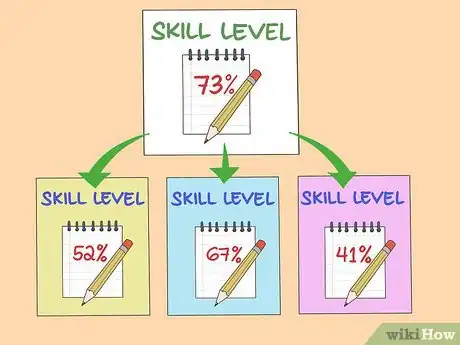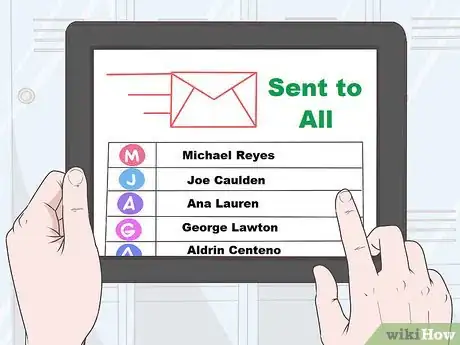This article was co-authored by Dan Klein and by wikiHow staff writer, Danielle Blinka, MA, MPA. Dan Klein is an improvisation expert and coach who teaches at the Stanford University Department of Theater and Performance Studies as well as at Stanford's Graduate School of Business. Dan has been teaching improvisation, creativity, and storytelling to students and organizations around the world for over 20 years. Dan received his BA from Stanford University in 1991.
This article has been viewed 53,236 times.
Group work is a great way to showcase your own skills while getting help from your teammates in areas where you might not be as strong. Our guide will show you how to boost your teamwork skills, even if you're used to working on your own.
Steps
Developing Good Teamwork Skills
-
1Show you’re reliable by doing everything you say you will. Your actions will reflect on everyone in your group, so do your best to always follow through. Complete your portion of the workload, and speak up as soon as you notice any issues that may arise.[1]
- Always keep your promises to the group.
- If you do need to back out of a promise, take responsibility for it by telling your supervisor, client, or teacher that you had to withdraw from the project. After you notify your supervisor, client, or teacher, tell your team that you've had to back out. Don’t put your group in an awkward situation.
-
2Make sure you do an equal share of the work. No one likes a teammate who barely contributes to the project. Take on an equal part of the work, and speak up if you realize you aren’t doing your fair share. Not only will your group mates appreciate your work ethic, it will show your supervisor or instructor that you’re a good team player.[2]
- Keep in mind that some tasks may be harder than others. Make sure you and your teammates create a balanced workload that’s fair to everyone.
- If you feel like you are doing too much work, tell your team. You might say, “I noticed that our team assignments are a little bit imbalanced. I have extra work assigned to me that I’m hoping we can spread around.”
- If they still don't take on their fair share, talk to them one-on-one about their perspective on the project. Try to address their reasons for holding back. Then, compare your current roles and invite them to take a more active role in the project. If nothing helps, you may be able to talk to your supervisor or instructor, but doing so can be risky. Make sure you've tried to solve the issue as a team first.
Advertisement -
3Be direct and honest when you communicate with others. Always say what you mean, but use a professional tone. Similarly, don’t waste people’s time by padding the truth or being indirect about how you really feel.[3]
- This includes what you say and what you write in reports, memos, emails, or text messages.
- On a similar note, don’t gossip about or to your teammates.
-
4Share credit with your teammates. No one likes a credit hog, so don’t steal the spotlight. Treat the team’s accomplishments as a group success. Additionally, acknowledge the individual contributions made by your teammates.[4]
- For instance, you might give your teammate credit for having a great idea that helped your team finish your project in half the time.
- Even if you’re the team leader, it’s important that you not hog the credit. A team success belongs to everyone.
- If someone really didn't help the team, talk to them about team expectations and how they can contribute moving forward. You or your teammates may need to help manage their workload.
- If someone else tries to hog the credit, you have a few choices on how to handle the situation. In the moment, you could say, "Thanks for bringing that up, Sharon. We all worked hard these past few weeks to create this plan." If you can't speak up in the moment, confront your colleague calmly to discuss what happened. Ask them to explain why they indicated that they deserved all the credit. If this doesn't help, you may need to involve your supervisor, so make sure you keep records that show who did what as part of the team.
-
5Adopt a positive attitude when it comes to your work. People are more likely to enjoy working with you if you have a good attitude. You can improve your attitude by approaching problems as an opportunity, expecting a positive outcome, and adopting habits that improve your workday.[5]
- One way to always find the positive outcome is to consider your work never complete until something good comes out of it.
- Good habits to help your workday go more smoothly might include enjoying a mug of your favorite tea every afternoon, organizing your desk to reduce your stress levels, and enjoying a brief, energizing walk at lunch time.
Working Independently While on a Team
-
1Take initiative when working on your collaborations to the team. Although you’re working on a team, you’ll likely complete some of the work alone. Don’t expect your teammates to take responsibility for keeping you on track. Be a self-starter by staying on top of your assignments, creating deadlines for yourself, and meeting project expectations.[6]
- This also shows your supervisor and teammates that you’re able to work independently of the team.
-
2Speak up when you have ideas or expertise about a topic. This shows leadership skills, while also making you a valuable part of the team. Sharing your thoughts shows that you have more to offer and are thinking outside the box. Even if your ideas aren’t right for the project, they might lead to future innovations on a different project.[7]
- When you have team meetings, always contribute something to the discussion. If you have trouble thinking on the spot, brainstorm before the meeting so you have some ideas about what you have to say.
-
3Volunteer to take on extra work, when necessary. This is another way to show that you’re not only a good team member but also an independent worker. Step up to lead a project, knock out a backlog of unfinished tasks, or complete a side project for your supervisor. Then, complete the extra work as quickly as possible.[8]
- You’ll show your independence by setting priorities between each of your work tasks, creating new deadlines for yourself, and following through on your promises.
- When you take on these extra projects, you’ll quickly gain a reputation for being a self-starter and an asset to the organization.
- Make sure that you don't take on too much work. You'll need to balance your new projects with your current work assignments. Know your schedule so you don't accidentally put too much on your plate.
Completing a Team Project
-
1Pick team members who have skills that complement yours, if you can. If you have a choice on who you’ll work with, look for people who are different from you. Although it’s tempting to pick similar people so your work will go smoothly, it’s better to have diverse ideas and skill sets on your team, as you’ll be able to be more creative.[9]
- If everyone has the exact same perspective and skill set, it will be harder to divide the work because everyone will want to do the same things. For instance, let's say you're working on a project to design a brochure. If everyone on your team enjoys graphic design, you'll all want to create the brochure, instead of tasks like conducting research on your topic.
- Additionally, your group won’t be as innovative in your ideas because you won’t be coming at the topic from different perspectives. For example, team members from different socioeconomic backgrounds might have experienced a community issue in a different way, giving them a different perspective on it.
-
2Compare skills sets with your teammates if your team is already chosen. Talk to your teammates to find out their background, strengths, weaknesses, and interests. Determine what you each bring to the table. Try to find ways you can complement each other’s skills so your team can work well together.
- If you're the team leader, you might host a planning meeting and invite everyone to share their skills. If you're not in a leadership position, talk to people one-on-one. Look for ways that you can bring something new to the team.
- For example, let's say you find out your teammates are strong in skills like networking with clients, statistics, and design. Although you might also be strong in networking and design, you could offer to use your writing skills to complement the skills of your teammates.
-
3Include input from all team members so everyone is heard. A team can only thrive if everyone feels valued and heard. Not all ideas are winners, but the group must still listen to them and consider if they’re a good idea for this project. Make it a priority to collaborate as much as possible.[10]
- If team members start to feel as though their ideas don’t matter, they’ll stop being an active part of the team. This will hurt your overall output as you’re losing valuable ideas and expertise.
- For example, you might host round table meetings to encourage participation.
- If you feel like people on your team aren't listening to you, talk to your team lead about it. Say, "At the past three meetings, I've tried to offer input on the project, but I keep getting interrupted. Do you think we can try a round table approach so we can also share our ideas?"
-
4Participate in goal setting as a team so you have a plan. It’s important that all team members are working on the same goals, rather than each person pursuing personal aspirations. Discuss your goals as a team and adopt the goals that everyone agrees on. Moving forward, you can change or adapt your goals as needed, as long as everyone provides input.[11]
- Be as active in the goal setting process as possible. If your team leadership already set goals for your group, you might not get a voice in the process.
- For example, your team might start out with 3 goals: “1) Design a survey to gather public input about our park project; 2) Distribute the survey to residents; and 3) Evaluate the survey results to determine how to proceed with phase 2 of our planning project.”
-
5Clarify the team expectations so everyone is on the same page. This can include explaining the expectations or asking questions if you find them unclear. It’s likely that each teammate has a different idea about what’s expected of them, as well as what everyone else needs to be doing. It’s essential that the team discuss these expectations and agree on one universal list of expectations that everyone will follow.[12]
- If you're not a leader on your team, you may not be setting expectations. However, it is important that you understand them, so ask questions if you're confused.
- Write down the expectations and make sure everyone on the team has a copy. For example, you might email the copy to everyone or post it in a communal Google Drive folder.
- Examples of expectations might be “everyone completes their work on time,” “check team communications daily,” “upload all work to the communal folder,” etc.
-
6Participate in brainstorming sessions to encourage collaboration. When you can, meet in person so you can have a free exchange of ideas. If this isn't possible, schedule a group phone call or digital conference through service providers like Google or Skype.[13]
- Teams are most effective when they collaborate, so brainstorming sessions are a great tool for good teamwork.
- Make sure each teammate is taking notes during the meeting so that you can all recall your ideas later.
-
7Establish a universal means of communicating with the team. Choose one method of communication. Make sure all team members have access to the means of communication so everyone is on the same page. Otherwise, your group may not work effectively, as some group members may be unaware of what’s happening.[14]
- For example, all group members might participate on a group text message or email.
- If you have no control over how communication is handled, that's okay! Follow along with the guidelines set up by your group leader.
-
8Focus on the success of the group, not your personal success. When you’re on a team, everyone’s success depends on each member working toward a common goal. If you’re thinking about your own glory, you’ll be undermining the team. Keep your focus on your team’s success, and your own success will follow.[15]
- It’s helpful to remember that a team failure will reflect badly on you. Don’t let your personal aspirations get in the way of your team’s success.
- Let's say your personal goal is to make it onto the management team. Rather than trying to impress your supervisor with your managerial skills, work with your teammates to accomplish your shared goals. Do your best to support the team, which shows you're an asset to the company. Then, you can volunteer for side projects that will help show your full range of skills.
Resolving Team Conflicts
-
1Discuss the issue in person with your teammates. Talking things out in person will allow a free-flow of information and prevent misunderstandings, which might occur if you bring up the issue in an email. State the issue you're having, then listen to what everyone has to say.[16]
- If you're concerned about having a record of the conversation, you can record it using your phone or a voice recorder.
- If you aren't the group leader, you may prefer to talk to your group leader before talking to the group as a whole. This may be helpful if you'd rather the leader bring up the issue.
-
2Direct your concern toward the problem, not your teammates. Don’t accuse or blame anyone on your team for causing the conflict, even if you believe they did. Instead, keep all of your comments and arguments focused on the issue and how your team can solve it.[17]
- If you feel attacked by the other person, don’t respond with your own attack. Say something like, “I’m sorry you feel that way, but blaming each other won’t help us solve the conflict. I’d like to stay focused on solutions.” This way, you show that you’re a professional and care more about the project than your ego.
- You may not have much control about how the conflict is handled. However, you can control what you say and how you react. Keep your words and actions professional.
-
3Give everyone a chance to share their opinion if you're a leader. Even if you think you’re right, it’s still important to hear everyone out. Otherwise, your conflict will continue even after you’ve solved this issue, as you’ll create resentments on the team.[18]
- For instance, you might host a round-table to allow everyone a chance to speak. Don’t respond to each other until everyone has shared their opinion.
-
4Listen to each side of the conflict. Focus on what the other person is saying, not what you will say in response. You may even take notes about what they say. Once they're finished speaking, repeat what they said back to them to make sure you really understand what they’re saying.
- In most cases, conflict on a team happens because people have different perspectives and backgrounds. This is actually a good thing! Understanding everyone’s opinion and why they feel that way will help you create a better solution to the problem, which eventually helps your team produce better work.[19]
- You might paraphrase their words by saying, “It sounds like you think your part of the workload is too heavy and that the rest of us need to do more.”
-
5Use conflict to generate new ideas whenever possible. When group members start to disagree, look for opportunities to get creative or go in a different direction. Let conflict be a trigger for brainstorming sessions, with the goal of choosing the best ideas. Make a habit of saving unused ideas or information for use in the future.[20]
- Assume that there’s no one way to do something, even if you feel like your ideas are the best.
- Keep notes about what comes out during your brainstorming sessions so you can refer back to those ideas later. This will help your team resolve conflicts more easily because people know that their ideas are being valued and may be used in the future.
-
6Create a compromise so that everyone feels included. You likely won’t win when there’s a conflict in your group, and that’s okay. Whenever possible, teammates should give and take so that everyone gets to direct the group’s efforts. Be open to a compromise that works best for everyone.[21]
- If you can’t compromise due to constraints, offer the team members who aren’t getting what they want something else they want. This way they’ll still feel included on the decision.
- For instance, let's say 2 team members aren't happy with their job assignments, but it's too close to the deadline to switch roles. Your compromise might be phrased like this, "Although we can't change the roles for this project, Maria and James are going to take the design lead on the upcoming project."
Expert Q&A
-
QuestionHow do you encourage your team to share ideas?
 Dan KleinDan Klein is an improvisation expert and coach who teaches at the Stanford University Department of Theater and Performance Studies as well as at Stanford's Graduate School of Business. Dan has been teaching improvisation, creativity, and storytelling to students and organizations around the world for over 20 years. Dan received his BA from Stanford University in 1991.
Dan KleinDan Klein is an improvisation expert and coach who teaches at the Stanford University Department of Theater and Performance Studies as well as at Stanford's Graduate School of Business. Dan has been teaching improvisation, creativity, and storytelling to students and organizations around the world for over 20 years. Dan received his BA from Stanford University in 1991.
Improvisation Coach It’s my belief that creativity is best served when you are grateful for the ideas shared with you and generous with your own ideas.
It’s my belief that creativity is best served when you are grateful for the ideas shared with you and generous with your own ideas.
References
- ↑ https://www.psychologytoday.com/us/blog/cutting-edge-leadership/201301/characteristics-good-work-team-members
- ↑ https://www.psychologytoday.com/us/blog/cutting-edge-leadership/201301/characteristics-good-work-team-members
- ↑ https://www.psychologytoday.com/us/blog/cutting-edge-leadership/201301/characteristics-good-work-team-members
- ↑ https://www.psychologytoday.com/us/blog/cutting-edge-leadership/201301/characteristics-good-work-team-members
- ↑ https://www.psychologytoday.com/us/blog/cutting-edge-leadership/201301/characteristics-good-work-team-members
- ↑ https://www.inc.com/john-baldoni/the-secret-to-team-collaboration-is-individuality.html
- ↑ https://www.forbes.com/sites/brettsteenbarger/2018/06/29/three-strategies-for-making-your-team-work/#67b231444f88
- ↑ https://www.psychologytoday.com/us/blog/cutting-edge-leadership/201301/characteristics-good-work-team-members
- ↑ https://www.forbes.com/sites/brettsteenbarger/2018/06/29/three-strategies-for-making-your-team-work/#67b231444f88
- ↑ https://www.forbes.com/sites/brettsteenbarger/2018/06/29/three-strategies-for-making-your-team-work/#67b231444f88
- ↑ https://www.entrepreneur.com/article/302126
- ↑ https://www.entrepreneur.com/article/302126
- ↑ https://www.businessnewsdaily.com/6139-workplace-collaboration-tips.html
- ↑ https://www.businessnewsdaily.com/6139-workplace-collaboration-tips.html
- ↑ https://www.forbes.com/sites/brettsteenbarger/2018/06/29/three-strategies-for-making-your-team-work/#67b231444f88
- ↑ http://www.innovativeteambuilding.co.uk/resolving-conflict-in-work-team/
- ↑ http://www.innovativeteambuilding.co.uk/resolving-conflict-in-work-team/
- ↑ http://www.innovativeteambuilding.co.uk/resolving-conflict-in-work-team/
- ↑ http://www.innovativeteambuilding.co.uk/resolving-conflict-in-work-team/
- ↑ http://www.innovativeteambuilding.co.uk/resolving-conflict-in-work-team/
- ↑ http://www.innovativeteambuilding.co.uk/resolving-conflict-in-work-team/
- ↑ https://www.entrepreneur.com/article/302126
About This Article
To work well with a team, you should follow through on your commitments, do your share of the work, and communicate clearly with your team members. Since your actions reflect on everyone else, make sure to keep up with deadlines and let your team know if you’re not able to finish something. You should also take on the same amount of work as everyone else to show that you want to be an equal contributor. Along with sharing the work, don't forget to share the credit so you don't come off as a credit hog. While you should take credit for something you did, try to acknowledge your teammates if they helped you in any way. Most importantly, have a positive outlook when you're around your team members, since no one enjoys working with a negative person. For more advice from our co-author, like how to engage and motivate your team with brainstorming sessions keep reading!







































































